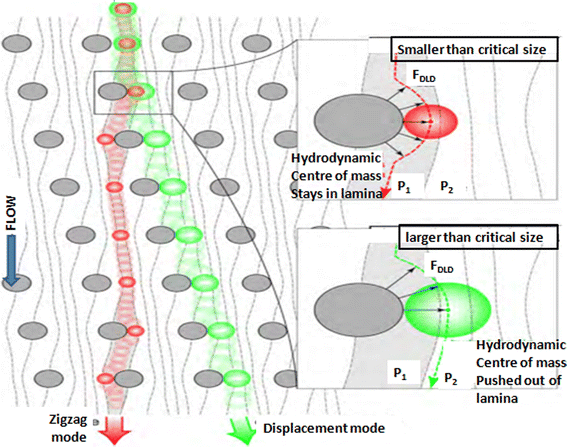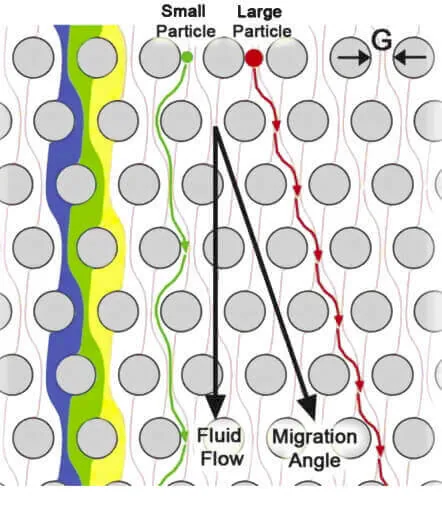Microfluidic Particle Size Sorting
Spiral channel for microfluidic inertial particle sorting by size
Spiral particle sorting chip
Passive, inertia-based sorting of the particles by size
Easy particle sorting experiment
Unbox, set up and start your experiments right away
The advantages of microfluidic
Low reagent consumption, improved safety, easier to use

Need a microfluidic SME partner for your Horizon Europe project?
Microfluidic particle sorting
Particles can be sorted depending on their size by using the microfluidic particle size sorting pack. This pack is based on a high-accuracy flow controller and a spiral sorter chip or a pillar sorter chip; this all-in-one solution contains all the required microfluidic instruments to set up a particle sorting system with a high flow rate and good performance.
The particle separation technique is label-free, membrane-free, and is based on well-understood dean and inertial forces. This pack can also be used to separate sperm cells from red blood cells or to filter samples.
Microfluidic particle sorting pack setup
A microfluidic particle sorting pack contains a microfluidic flow controller and flow sensor (more about the Galileo project, our new flow sensor, here) to push the sample containing the particles inside the microfluidic chip that uses inertial forces to separate them by size. The sorting efficiency will be directly linked to the fluid’s properties and the flow rate inside the channel.
This pack combines compatible instruments and allows you to start the experiment quickly. A single software pilots everything, which can be adapted and applied to other ends. This is why we develop packs for researchers and industries that are beginners or experts in microfluidics. The following figure summarizes the montage that can be set up with the pack.

Setup
Flow sensor (Galileo, MIC)
Software (Galileo user interface)
Flow controller
15 mL Falcons
A commercial spiral or pillars microfluidic chip with several outlets
All necessary accessories: connectors, filters, tubing, etc…
Microfluidic particle size sorting principle
Inertial microfluidics can be used for many different processes like live-dead cell separation, blood cell sorting, or filtering specific particles [1].
The microfluidic particle size sorting Pack uses a label-free inertial separation and sorting technique using Dean forces that create vortices inside the microchannel [2]. These vortices appear in the spiral-shaped channel because of the difference in flow speed between the fluid near the inner wall of the channel and the fluid’s flow speed near the microfluidic channel’s outer wall [3].
Therefore, the hydrodynamic forces create a separation between the smaller particles dragged toward the spiral’s center and the larger particles dragged toward the microchannel’s outer wall [4].
The effectiveness of the sorting depends on the Dean Number. This number increases when the Reynolds number increases, and the radius of curvature decreases [3].
Particles can also be passively sorted using pillars that induce deterministic lateral displacement (DLD) [4-5].

References
Herrmann N, Neubauer P, Birkholz M. Spiral microfluidic devices for cell separation and sorting in bioprocesses. Biomicrofluidics. 2019;13(6):061501
Pu Chen, Xiaojun Feng, Wei Du, Bi-Feng Liu, Microfluidic chips for cell sorting, Frontiers in Bioscience 13, 2464-2483, January 1, 2008
Nivedita, N., Ligrani, P. & Papautsky, I. Dean Flow Dynamics in Low-Aspect Ratio Spiral Microchannels. Sci Rep 7, 44072 (2017).
Beech, Jason P. “Separation and analysis of biological particles”
Bayareh, Morteza. “An updated review on particle separation in passive microfluidic devices.” Chemical Engineering and Processing-Process Intensification 153 (2020): 107984.
Why use microfluidics for particle size sorting?
Particle sorting on microchips is more straightforward than conventional methods. It is label-free, relies only on mechanical forces, and eliminates potential biohazardous aerosols.
Particle sorting using a spiral microchannel relies on the more vital Dean forces when the Reynolds number is low. The Reynolds number in a microfluidic channel is usually deficient; therefore, this particle sorting technique is almost only usable in microfluidics experiment conditions.
Another microfluidic sorting technique is the deterministic displacement technique, a size-based particle sorting technique consisting of an ordered array of obstacles that forces the direction of the particle flowing through the pillars in a specific direction depending on its size.
Tuning the fluid velocity can optimize particle sorting. Various entities can be separated using up to several different outlets on the microfluidic chip.
Microfluidic sorting techniques allow more flexible, precise, and efficient particle sorting.

References
1. Inglis, David W., et al. “Critical particle size for fractionation by deterministic lateral displacement.” Lab on a Chip 6.5 (2006): 655-658.
Customize your pack
Our microfluidic experts will help you throughout the whole setup process of your experiment, making this pack usable by microfluidic technology beginner users.
It is possible to find commercially available spiral and pillar chips for particle sorting with different materials, spiral, and channel sizes. You can also fabricate your design with various fabrication methods.
The efficiency of the sorting depends on the Reynolds and the Dean numbers.
Contact our experts to answer any questions about the particle sorting pack and how it can match your specifications.
Frequently asked questions
How can we help your experiment?
This pack is in beta testing phase. So, although the instruments are not fully industrialized, we can provide extensive support as part of our beta testing program. Get in touch to see if you are eligible.
Can the pack be customized based on my specific application?
Yes! Our experts will establish which instruments are best suited for your application, such as the type of flow sensor or the number of flow controller channels you need to perform your experiment. Contact us using the “talk to our experts” green button above.
Can I buy individual instruments?
Our instruments are in beta testing phase and can be tested as a pack or individually, so get in contact with our team to know how our beta testing program works.

